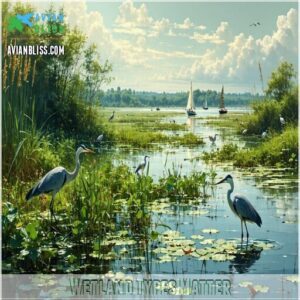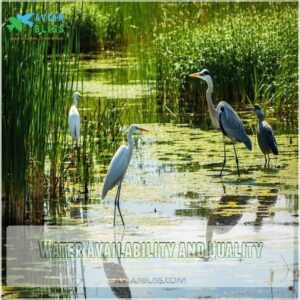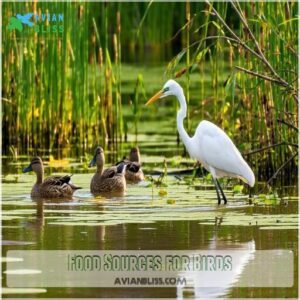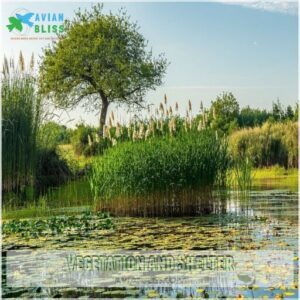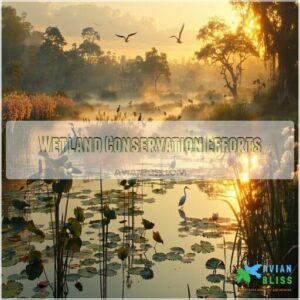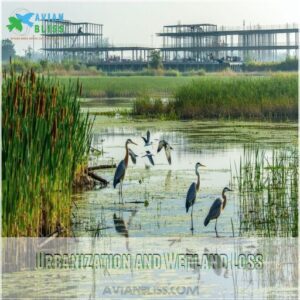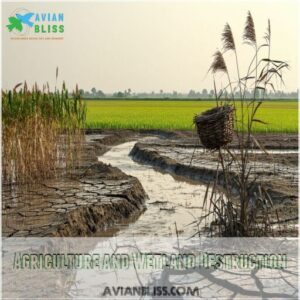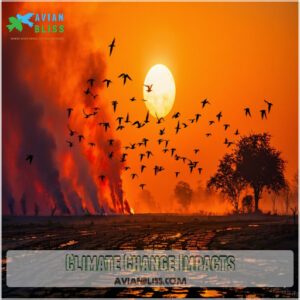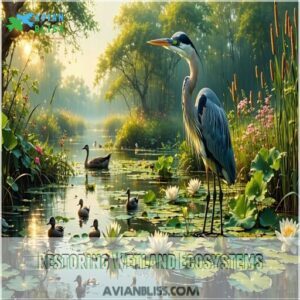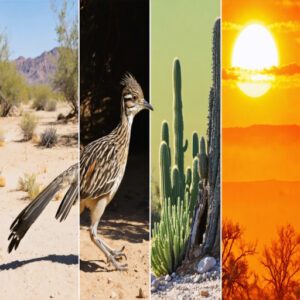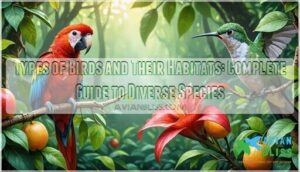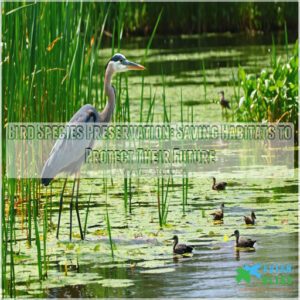This site is supported by our readers. We may earn a commission, at no cost to you, if you purchase through links.
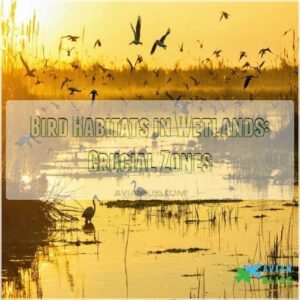
Wetlands, including marshes, swamps, and lakes, provide essential food, shelter, and breeding grounds.
As you learn about these ecosystems, you’ll discover how water availability, quality, and vegetation impact bird habitats in wetlands, and why conservation efforts are necessary to protect them, which is exactly what we’ll be discussing next.
Table Of Contents
- Key Takeaways
- Wetland Types Matter
- Bird Habitat Requirements
- Wetland Conservation Efforts
- Threats to Wetland Habitats
- Restoring Wetland Ecosystems
- Frequently Asked Questions (FAQs)
- What type of birds live in wetlands?
- Why are the wetlands a good habitat for breeding of birds?
- What habitats are in the wetlands?
- How do birds find their way to wetlands?
- What diseases commonly affect birds in wetland environments?
- Do artificial wetlands attract the same bird species?
- How do wetland birds communicate with each other?
- Can wetland birds adapt to urban water features?
- Conclusion
Key Takeaways
- You’ll find that different types of wetlands, like marshes, swamps, and lakes, support unique bird habitats, and understanding these ecosystems is crucial for conservation efforts.
- Wetlands provide essential food, shelter, and breeding grounds for birds, and you’ll need to consider factors like water availability, quality, and vegetation to protect these habitats.
- Human activities, such as urbanization, agriculture, and climate change, pose significant threats to wetland habitats, and you’ll need to address these issues to preserve bird populations.
- Conservation efforts, including national wildlife refuges, the Federal Duck Stamp Program, and international treaties, are vital for protecting wetlands and the bird species that depend on them, and you can support these initiatives to make a positive impact.
Wetland Types Matter
You’ll find that different wetland types, such as marshes, swamps, and lakes, support unique bird habitats.
As you explore these ecosystems, you’ll discover that the characteristics of each wetland type play a fundamental role in determining the types of birds that inhabit them, which is a complete concept.
Marshes and Bird Habitats
You explore marshes, key bird habitats, and discover marsh ecology’s role in bird migration, with wetland plants supporting avian diversity.
Habitat restoration efforts protect marshland wildlife and shorebird habitats within wetland ecosystems, specifically avian habitats.
Wetlands provide critical floodwater storage and filtration.
Swamps and Forested Wetlands
You’ll find various bird species in forested ecosystems, like swamps, with wetland canopies and tree species supporting marshland wildlife and wetland biodiversity, creating unique aquatic habitats and bird habitats within these ecosystems.
Wetlands provide essential bird habitat factors, including food sources, nesting sites, and shelter, which are crucial for the survival of bird species in these areas.
These ecosystems support a wide range of bird life by offering unique aquatic habitats and necessary resources for birds to thrive.
Lakes and Ponds as Bird Habitats
You often visit lakes and ponds, which are key bird habitats.
- Water Depth
- Bird Migration
- Lake Ecology
- Pond Management support aquatic life in these freshwater habitats, making lakes and ponds important wetland habitats for various bird species.
Understanding bird habitat types is essential for conservation efforts, and you can learn more at bird habitat types, which provides valuable insights into the importance of these freshwater habitats.
Bird Habitat Requirements
As you explore bird habitats in wetlands, you’ll find that they require specific conditions to thrive.
You need to evaluate water availability and quality, food sources, and vegetation that provides shelter to understand the complex needs of birds in these ecosystems.
Water Availability and Quality
You assess water availability and quality in wetlands, considering water depth, aquatic life, and water chemistry, which impact flood patterns, sediment control, and overall wetland conservation, affecting freshwater habitats and waterfowl sanctuaries, including coastal wetlands.
Effective water management involves using water quality testers to monitor and maintain healthy aquatic ecosystems.
Through effective wetland management, you can ensure the long-term health of these critical environments.
Food Sources for Birds
Clean water isn’t enough; birds need chow! Wetland food webs offer a buffet. Bird feeding habits depend on what’s available. Think aquatic plants, insects, fish, and crustaceans.
Nutrient cycling supports this bounty. Here’s a peek:
- Insect prey fuels many wetland birds.
- Seed availability sustains others.
- Aquatic plants provide both food and shelter.
- Small invertebrates are a key food source.
- Nutrient cycling keeps the food web healthy.
Understanding bird diet diversity is paramount for maintaining a balanced ecosystem, and learning more about it can be done through resources like bird diet diversity, which highlights the importance of nutrient cycling.
Vegetation and Shelter
You’ll discover that vegetation and shelter are essential in wetlands, providing bird habitats with plant diversity, emergent growth, and aquatic plants.
While shelter types like canopy structure protect them, highlighting the importance of wetland conservation and habitat structure in preserving these critical ecosystems.
Wetland Conservation Efforts
You’re about to explore the essential efforts being made to conserve wetlands, which are critical habitats for numerous bird species.
As you learn about wetland conservation, you’ll discover the importance of initiatives like National Wildlife Refuges, the Federal Duck Stamp Program, and International Treaties in protecting these ecosystems.
National Wildlife Refuges
You manage national wildlife refuges, focusing on refuge management, wildlife protection, and habitat restoration.
This provides ecosystem services, supporting bird sanctuaries and wetland preservation, ultimately aiding conservation funding for these essential areas.
Including national parks, and wildlife refuges.
Federal Duck Stamp Program
You’ll find the Federal Duck Stamp Program supports Duck Conservation through Stamp Funding, aiding Wetland Acquisition and bird habitat preservation with Federal Grants, benefiting waterfowl and bird conservation in wetlands.
International Treaties and Agreements
International agreements, like the Ramsar Convention and the Migratory Bird Treaty Act, are essential for wetland conservation.
These global accords demonstrate international cooperation for bird conservation and wetland protection. They establish conservation laws promoting responsible wetland use.
Ongoing bird conservation efforts worldwide address threats like habitat loss and climate change.
The Ramsar Convention designates wetlands of international importance. The Migratory Bird Treaty Act protects migratory birds across borders.
These conservation treaties are essential for conservation efforts.
Threats to Wetland Habitats
You’re about to explore the threats to wetland habitats, which are key zones for bird habitats.
As you read on, you’ll learn about the main threats, including urbanization, agriculture, and climate change, that are impacting these essential ecosystems.
Urbanization and Wetland Loss
As you consider urbanization’s impact, note that it leads to wetland destruction, habitat fragmentation, and water pollution.
Ultimately, this causes wetland loss due to urban sprawl and land fragmentation, threatening wetlands and habitat destruction.
Agriculture and Wetland Destruction
Beyond the city limits, agriculture presents another challenge.
Farm runoff, laden with crop pollution, degrades wetlands. Water diversion for irrigation shrinks these essential ecosystems. Land reclamation for farming further reduces habitat, leaving birds with:
- Fewer nesting sites
- Diminished food sources
- Increased vulnerability to predators.
This habitat fragmentation and wetland loss in coastal wetlands and beyond severely impacts bird populations.
Climate Change Impacts
You see climate change impacting wetlands through rising temperatures, altering bird migration patterns, and causing ecosystem shifts, leading to habitat loss and wetland loss due to drought effects and sea level changes, all exacerbated by carbon emissions.
The effects of climate change are closely linked to climate change impacts on bird populations and their habitats.
Restoring Wetland Ecosystems
You’re now focusing on restoring wetland ecosystems, a critical step in preserving bird habitats.
By understanding the importance of community-based conservation projects and wetland restoration techniques, you can help protect these important areas for bird populations.
Community-Based Conservation Projects
You can support community-based conservation projects through local outreach and volunteer training, fostering conservation partnerships to protect bird habitats and promote wildlife conservation.
This approach is key to successful wetland conservation partnerships and community-based conservation efforts.
Wetland Restoration Techniques
You undertake wetland restoration techniques, such as Water Renewal and Soil Restoration, to rebuild habitats, promoting Ecosystem Repair and Wetland Revival through Habitat Rebuild, a key aspect of wetland conservation and management.
Effective wetland restoration also involves utilizing proper Wetland Restoration tools to support these efforts, which is crucial for Ecosystem Repair.
Global Cooperation for Wetland Sustainability
You can promote wetland conservation through international partnerships, securing wetland funding, and implementing global policies that support sustainable practices and eco diplomacy.
Ultimately, this approach protects bird habitats and ecosystem services within wetlands.
Frequently Asked Questions (FAQs)
What type of birds live in wetlands?
Like a vibrant tapestry, wetlands host diverse birds including Black Terns, Least Bitterns, and Common Gallinules.
You’ll find these species nesting, feeding, and resting in marshes, swamps, and lakes throughout the year.
Why are the wetlands a good habitat for breeding of birds?
Wetlands offer you ideal breeding conditions with abundant food, protective vegetation, and varying water depths.
You’ll find these areas provide perfect shelter from predators while offering diverse nesting spots and essential nutrients for chicks, making them a haven with abundant food.
What habitats are in the wetlands?
Picture a vibrant mosaic of nature’s finest – you’ll find diverse habitats including
marshes teeming with plants,
forested swamps with standing water,
acidic bogs covered in moss,
and lakes perfect for swimming birds.
How do birds find their way to wetlands?
Birds use their incredible internal compass, following magnetic fields, stars, and landmarks. You’ll find they rely on memory, seasonal cues, and inherited migration patterns to navigate back to wetland destinations.
What diseases commonly affect birds in wetland environments?
Disease threats you’ll commonly encounter include avian botulism, avian cholera, duck virus enteritis, and West Nile virus.
These pathogens can spread rapidly through shared water sources and close contact between birds.
Do artificial wetlands attract the same bird species?
You’ll find that artificial wetlands can attract many of the same bird species, but they won’t match natural wetlands’ diversity.
Still, they’re valuable stopovers where you’ll spot ducks, herons, and wading birds.
How do wetland birds communicate with each other?
You’ll notice wetland birds use a variety of vocalizations, such as whistles, trills, and honks, to communicate their territory, attract mates, warn of danger, and coordinate movement within their groups.
Can wetland birds adapt to urban water features?
Where there’s water, there’s a way!
You’ll find that wetland birds can adapt to urban fountains, ponds, and artificial lakes, though they’ll need proper vegetation and food sources to thrive successfully.
Conclusion
Now, you see the importance of preserving bird habitats in wetlands, which provide essential food and shelter.
Making conservation efforts essential to protect these ecosystems and the species that depend on them, like bird habitats in wetlands, is crucial for their survival, and thus, conservation efforts are vital.
- https://water.usgs.gov/nwsum/WSP2425/birdhabitat.html
- https://dec.vermont.gov/watershed/wetlands/functions/wildlife
- https://www.pewtrusts.org/en/research-and-analysis/articles/2024/05/11/coastal-wetlands-offer-needed-haven-for-imperiled-birds
- https://pacificbirds.org/priority-habitats/estuaries/
- https://gl.audubon.org/news/what-wetland-and-other-habitats-great-lakes-birds-need

